Calgary International Airport
Calgary International Airport (IATA: YYC, ICAO: CYYC), branded as YYC Calgary International Airport, is an international airport that serves the city of Calgary, Alberta, Canada. It is located approximately 17 km (11 mi) northeast of downtown and covers an area of 21.36 km2 (8.25 sq mi).[3] With 17.96 million passengers and 238,843 aircraft movements in 2019, Calgary International is the busiest airport in Alberta and the fourth-busiest in Canada by both measures.[4][5] The region's petroleum and tourism industries (and its proximity to Banff National Park) have helped foster growth at the airport, which has nonstop flights to an array of destinations in North and Central America, Europe, and Asia. Calgary serves as the headquarters for WestJet and is a hub for Air Canada.[6][7]
YYC Calgary International Airport Aéroport international de Calgary YYC | |||||||||||||||||||||||
|---|---|---|---|---|---|---|---|---|---|---|---|---|---|---|---|---|---|---|---|---|---|---|---|
 | |||||||||||||||||||||||
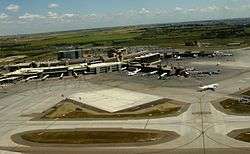 | |||||||||||||||||||||||
| Summary | |||||||||||||||||||||||
| Airport type | Public | ||||||||||||||||||||||
| Owner | Transport Canada | ||||||||||||||||||||||
| Operator | Calgary Airport Authority | ||||||||||||||||||||||
| Serves | Calgary, Alberta, Canada | ||||||||||||||||||||||
| Hub for | |||||||||||||||||||||||
| Time zone | MST (UTC−07:00) | ||||||||||||||||||||||
| • Summer (DST) | MDT (UTC−06:00) | ||||||||||||||||||||||
| Elevation AMSL | 3,606 ft / 1,099 m | ||||||||||||||||||||||
| Coordinates | 51°07′21″N 114°00′48″W | ||||||||||||||||||||||
| Website | www | ||||||||||||||||||||||
| Map | |||||||||||||||||||||||
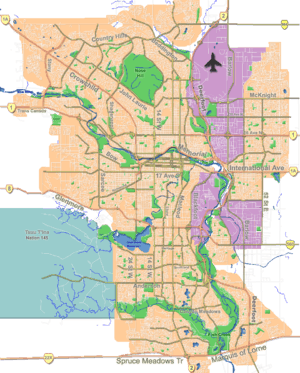 YYC 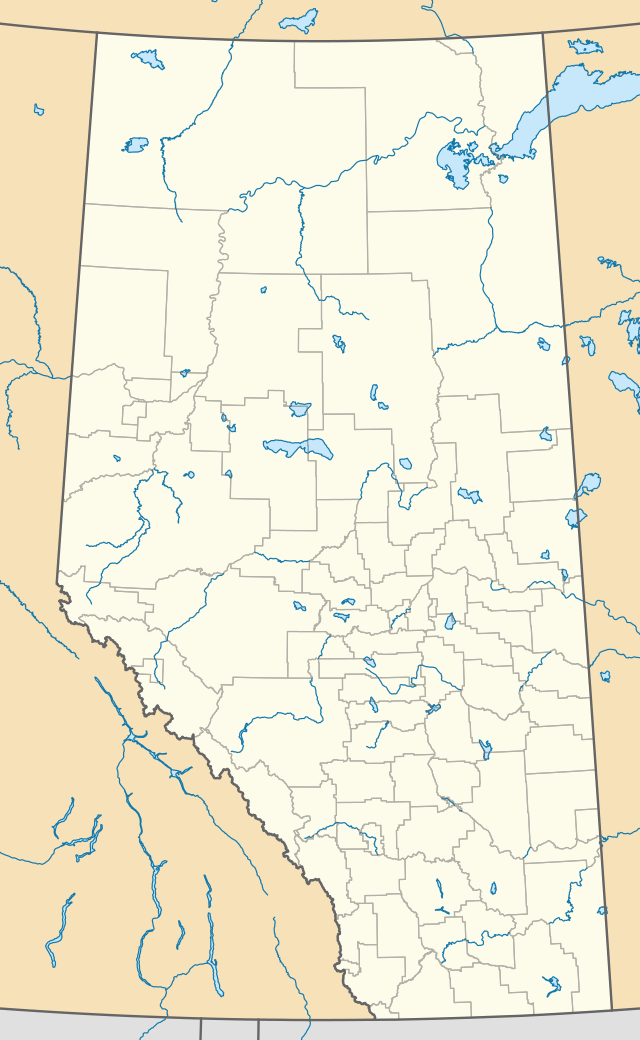 YYC 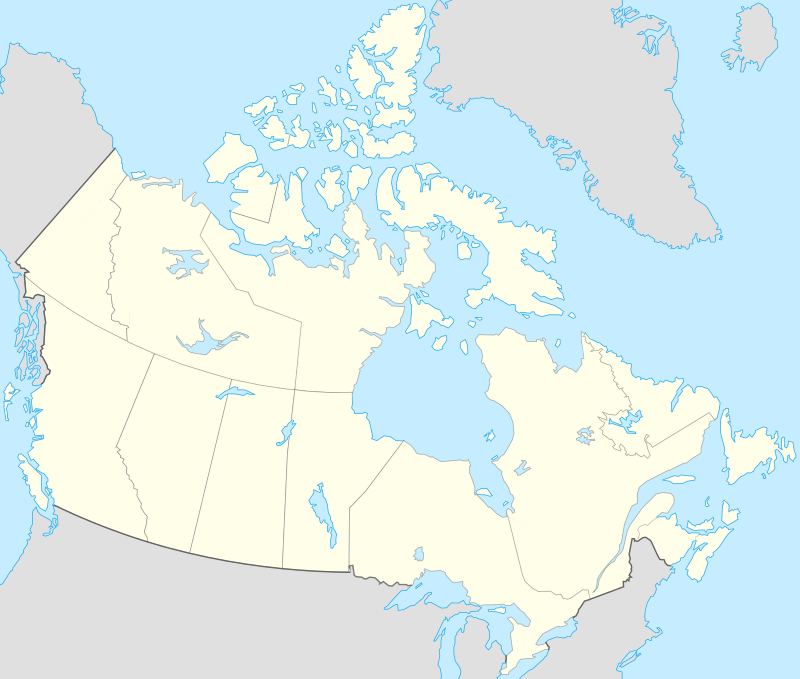 YYC  YYC | |||||||||||||||||||||||
| Runways | |||||||||||||||||||||||
| |||||||||||||||||||||||
| Statistics (2019) | |||||||||||||||||||||||
| |||||||||||||||||||||||
Built in the late 1930s, the site has since grown to house four runways, two terminal buildings with 5 concourses for passengers, warehouses for cargo handling, and other infrastructure. The Calgary Airport Authority operates the property while paying rent to the federal government. Close to the airport is the Deerfoot Trail freeway for transport into the city, and public transit also serves the airport.
History
Early history
The first airport to serve Calgary opened in 1914, in the neighbourhood of Bowness. It occupied one square kilometre (0.39 sq mi) and consisted of a hut and a grass runway.[8][9] Operations shifted to a new airport southwest of the city in 1928, named Old Banff Coach Road Airport. However, issues with turbulence in the area prompted another airfield to be built the following year in the neighbourhood of Renfrew known as the Calgary Municipal Airport[9] or Stanley Jones Airport.[10] The local airline Renfew Air Service would construct the Rutledge Hangar at the Renfrew site in 1929,[10] a lamella arch structure composed of Douglas Fir planks on a reinforced concrete base. The Renfew Air Service would fold in November 1931 as a result of the Great Depression,[10] and ownership of the Rutledge Hangar would be taken over by the Edmonton Credit Corporation who would subsequently lease the hangar to the City of Calgary. The Rutledge Hangar remains standing at the original Renfew site and was designated a Alberta Provincial Historic Resource on 5 May 2003.[10]
Present site & Second World War
As the City of Calgary grew to surround the Renfrew airport site the municipal government decided to relocate the airport to a new location. The city purchased an area of land north of Calgary in 1938 for about $31,000; and remains the site of Calgary's current airport. The city would come to an agreement with Trans-Canada Air Lines to construct and lease a hanger on the site for $45,000 (equivalent to $779,610 in 2018),[11] and the federal Department of Transportation financed the construction of three runways and other improvements, the first of which opened on 25 September.[11][12] The new Calgary airfield was named McCall Field after First World War ace and lifelong Calgarian Fred McCall.[8][13]
As a result of Canada entering the Second World War, the federal government assumed control of McCall Field in 1940, re-purposing it as a fuel and maintenance stop for aircraft involved in the war effort and later stationing the No. 37 Service Flying Training School at the airfield from 22 October 1941 until its closure on 10 March 1944.[14] McCall Field continued to operate regular passenger flights the Second World War.[8][9]
Following the end of the Second World War, the airport had been expanded to include additional hangars, four runways and other infrastructure.[8] The City of Calgary resumed management of McCall Field in 1946, repurposed the a hangar as a passenger terminal, and would convince the federal government to extend the airports 4,125 ft east-west runway to 6,200 ft (1,890 m) in October 1949 at an estimated cost of $750,000 the construction required a five-foot excavation below grade to prevent frost heaving.[15] At the time of completion, McCall Field's east-west runway would be the third-longest runway in Alberta behind the Calgary Airport's north-south runway and the runway at CFB Namao.[16].[9]
1950s & 1960s, terminal expansion and jet age
The re-purposed military hangers would not meet the needs of the growing transportation needs of the city, and efforts were made by city officials to secure funding for a new passenger terminal. A new passenger terminal would be constructed in 1956, however the design for the terminal originated in the 1950s as an thesis project by Provincial Institute of Technology and Art architecture student Ken Bond, who would later form the architectural firm Clayton, Bond and Mogridge which would be awarded the contract for designing the new terminal.[17] The one-million dollar project featured an open public concourse, and ticketing offices for three airlines was dubbed one of the most modern air terminals in Canada when it opened on 2 June 1956.[17] A lavished opening ceremony was attended by federal Transportation Minister George C. Marler, Lieutenant Governor of Alberta John J. Bowlen, and Mayor Donald Hugh Mackay, and a number of other dignitaries.[18] The festivities included an air show featuring an Avro Canada CF-100 Canuck.[17][8][9] Following construction of the new passenger terminal, McCall Field would see 110,984 passenger arrivals, 96,287 departures and nearly 1,000,000 pounds of cargo through the airport in 1957.[19]
In the 1960s Calgary City Council began lobbing the federal government to designate McCall Field as an "international airport", a status defined by the Department of Transportation. As a compromise on 6 April 1962, the federal government approved the naming the airport terminal Calgary International Airport from Calgary Municipal Airport. However, Mayor Harry Hays, local Aldermen and residents continued to refer to the airport in general as McCall Field.[20] Calgary International Airport would not receive official "International" status from the federal government until 1969.[21] The first non-stop transatlantic flights were scheduled by Canadian Pacific Airlines in 1961, connecting Calgary with Amsterdam Airport Schiphol, and more flights from Europe commenced the following year.[22]
The jet age arrived shortly after the construction of Calgary's new passenger terminal. The terminal was not designed with jet aircraft in mind, and the airport's runways were not suitable for the larger and faster aircraft. In 1961 the airport would replace the diagonal runway with an 8,000 ft runway capable of handling modern jet aircraft.[23] Later in 1963 the airport would undergo a $4-million refurbishment which saw improved electronic landing aids, and the main north-south runway extended by 4,675 feet to its present length of 12,675.[24]
The City of Calgary would be unable to afford the continued upgrades the Calgary Municipal Airport necessary to cope with the rising aircraft traffic.[8][9] The city proceeded to sell the Calgary Municipal Airport to the federal government in 1966 for $2-million, and the Department of Transportation would proceed to refurbish the runways shortly afterwards.[8]
1970s, terminal and hub status
The new passenger terminal constructed in 1956 would only prove to temporarily meet the needs of the city, and was inadequate for expansion or facilitating jet aircraft servicing. Following the sale of the Calgary International Airport by the City of Calgary to the Government of Canada in 1966, plans were put in motion to build a new passenger terminal. The airport's sale came with a promise by Federal Transportation Minister Jack Pickersgill that the federal government would build a $20-million passenger terminal within five years, however continued delays would push completion of the terminal to 1977.[25]
Construction began on the new passenger terminal in 1972, construction would be delayed due to re-designs to meet increased air traffic needs, causing the price of the new terminal to grow well beyond the original $20-million figure.[25] Finally, on 12 October 1977, the new $130-million (equivalent to $854-million in 2018), 600,000 square foot terminal was opened by Mayor Rod Sykes, Provincial Transportation Minister Hugh Horner, and Federal Transportation Minister Otto Lang two months before construction had completed.[26] Sykes was able to leverage his friendship with Lord Mountbatten to convince British Airways to have one of the newly introduced Concorde land in Calgary on the day,[26] and although the jet showed up a day late due to mechanical issues, it was still quite the coup for a city of less than half a million residents.[27] Among other festivities for the opening event included flyovers by a Boeing 747, Lockheed F-104 Starfighter, and the Canadian Air Force Snowbirds.[26] The 1977 passenger terminal remains the core of Calgary International Airport's domestic terminal to this day.[8][9]
The Jumbo Jet age would arrive in Calgary with the newly introduced Boeing 747 landing for the first time in 1973, with Wardair providing non-stop bi-weekly charter service from Calgary to London.[28] Air Canada would not be far behind, and would begin non-stop service to London using the 747 starting on 27 June 1974.[29] In April 1974, Calgary International Airport would host CP Air's fight testing for the Boeing 747 after airport firefighters went on strike at both Vancouver International Airport and Toronto Pearson Airport.[30]
In 1974 the Government of Alberta would acquire ownership of Pacific Western Airlines, Canada's third largest airline at the time and move the head office and hub to Calgary.[31] The airline would continue under provincial government ownership until 1983,[31] and would later merge with Canadian Pacific Air Lines to form Canadian Airlines. Canadian Airlines would maintain Calgary as the hub and headquarters for the airline[32] until it was acquired by Air Canada in 2001.[33]
1990s Reorganization and Westjet
In the early 1990s the Government of Canada introduced the National Airports Policy which moved towards privatization, liberalization and economic deregulation of air transportation, which included the formation of a Local Airport Authority under the name Calgary Airport Authority in 1992 for the management, operation and development of the Calgary International Airport[34] under lease from the federal government.[8][35] The Calgary Airport Authority, incorporated in July 1990 is a non-share capital, not-for-profit corporation formed under the authority of Alberta's Regional Airports Authorities Act.[36] The Calgary Airport Authority would sign a long-term 60-year lease with an additional 20-year option, which was subsequently exercised in 2011.[36]
Later in 1992, Calgary International Airport would open a new Air Traffic Control Tower at the southern end of Aero Drive. The control tower when completed was 44 m (144 ft) tall with 38 m2 (409 sq ft) of office room,[37] and was designed with the knowledge that it would not provide the necessary line of sight to the expanded east airfield.[38]
In February 1996 WestJet, which began as a low-cost carrier began operations with a base of operations at Calgary International, occupying an expanded area of the terminal.[9][39] The airline's first flight, a Boeing 737 would depart Calgary International on route to Vancouver International Airport on 29 February 1996.[40]
Operation Yellow Ribbon
During the September 11, 2001 attacks 13 international flights destined for the United States were diverted to Calgary International Airport as part of Operation Yellow Ribbon. The operation was a joint effort between NAV Canada and Transport Canada in communication with the U.S. Federal Aviation Administration, which facilitated the grounding of potentially destructive air traffic.[41]
2000s, Runway and new terminal
The Calgary Airport Authority began analyzing the facility's air capacity in the late 1990s, and found the airport could reach its maximum capacity as early as 2006. The Airport Authority and NAV Canada made a number of changes to airport operations in the 2000s to improve the efficiency and capacity of the facility, however by 2008, with a number of changes made, NAV Canada reported the airfield would begin to exceed its practical capacity.[42] The Calgary Airport Authority planned and under the "Airport Development Program", a major development program aimed at improving the capacity and quality of the airport, which included the construction of a new runway, air traffic control tower and passenger terminal.
On 25 May 2013, the new Air Traffic Control Tower opened at Calgary International Airport. The one-year, $25-million (equivalent to $27-million) project came in advance of the airport's new runway, and at 91 m (300 ft), the tower was the tallest free-standing control tower in Canada.[43] The airport's previous 50 m (165 ft) control tower was demolished in October 2014.[37]
The Calgary Airport Authority initiated the Parallel Runway Project, a $620-million (equivalent to $661-million) project to assess and construct a new runway, which led to the construction of the 14,000 ft (4,267 m) runway 17L/35R beginning in April 2011. Upon its completion on 28 June 2014, runway 17L/35R would become the longest runway in Canada.[44] During the construction of the runway, a $295-million (equivalent to $314-million), 620 m (2,034 ft) meter, six-lane roadway tunnel was constructed underneath the tunnel to connect Barlow Trail to 36th Street N.E.[45] The decision for Calgary City Council on whether to construct the tunnel while the runway was being constructed, or wait until a later date was a major issue during the 2010 Calgary municipal election.[46]
The Airport Authority addressed cargo capacity through the construction of a 30,000 sq ft (2,787 m²) cargo facility in 2015 followed by a 100,000 sq ft (9,290 m²) facility constructed in 2016.[47]
The final stage of the Calgary Airport Authority's Airport Development Program was the construction of a new $1.6-billion (equivalent to $1.66-billion) international terminal.[9][48] Officially opened on 31 October 2016, the international terminal 186,000 m2 (2,002,087 sq ft) facility added 24 new aircraft gates, North America's first call-to-gate passenger boarding system, CATSA Plus enhanced passenger screening system, moving walkways and dedicated electric passenger vehicle system.[49] The international terminal was designed with several sustainable principles including 581 geothermal wells for heating and cooling, and an annual rainwater capture capacity of 800,000 litres.[47]
In October 2016 Transport Canada officially renamed Calgary International Airport to "YYC Calgary International Airport", affixing the "YYC" IATA code to the airport's name.[50]
Infrastructure
Passenger terminals
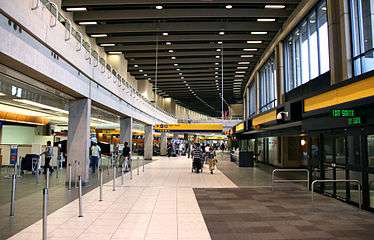
.jpg)
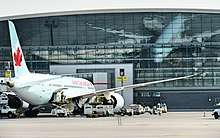
The Calgary International Airport houses two passenger terminals, one for domestic flights and the other for international flights.
The four-storey Domestic Terminal was originally opened in 1977 and has undergone a number of renovations in the decades following. The ground level of the terminal serves as the arrivals area with baggage claim and transportation facilities present. The second level of the terminal serves as the departures level and includes airport check-in, security and access to departure gates. The basement level of the airport contains utilites and tenant storage while the mezzanine level contains a food court, airline offices and the airport authority offices. The Domestic Terminal has three concourses, Concourse A includes departure gates A1-A24; Concourse B includes departure gates B31-B40; and Concourse C includes departure gates C50-C59, C61-C65, and C70-C73.[51]
The International Terminal was originally opened on 31 October 2016 and consists of five levels; utilities and baggage processing in the basement. Arrivals meet and greet areas, Canada Customs and relevant infrastructure on the ground level with departure check-in, security, US customs and the international departures concourse being located on the second floor. The third level contains the US departures concourse and finally the mezzanine level contains the international departure lounges. The domestic Concourse A,B and C are all used for domestic flights in Canada only. The International Terminal has two concourses, Concourse D for all flights to and from foreign countries except the US, and includes departure gates D70-D87; and Concourse E for flights to and from the United States, which includes departure gates E70-E97.[52][53] For the International Terminal, passengers travelling to the United States clear customs and immigration prior to departure at the preclearance facility.[54][55]
The Domestic Terminal is connected to the International Terminal by a 620 metre walkway corridor and path for the YYC Link Passengers Shuttles; twenty, ten-seat electric vehicles used to transport connecting passengers.[51][48]
WestJet has criticized the design of the international terminal, which opened in 2016. The airline's CEO stated that the distance between the terminals was too long for connecting travellers and that YYC Link was insufficient to solve this problem. As a result, WestJet had to alter its schedules in order to allow additional time for passengers transiting through Calgary.[56][57] The Calgary Airport Authority responded that it did not see issues with the connections process, although it said passengers would need some time to adjust to the new facilities.[56]
Runways
Calgary International Airport consists of two north/south parallel runways with two intersecting runways. The parallel runways are 17R/35L (west) which is generally used for aircraft arriving and departing to the west, and 17L/35R (east) which is generally used for aircraft arriving and departing to the east. During the winter months in Calgary, cold arctic air will move in from the north which means aircraft will primarily depart and arrive on north-facing runways (35R and 35L), while the summer months with warm winds from the south, aircraft will primarily take-off and land on south facing runways (17R and 17L). The diagonal runway 11/29 is generally used when crosswinds are present, which commonly occurs in the summer when westerly Chinooks roll into Calgary, or when extreme wind conditions prohibit the use of the parallel runways. The fourth and smallest runway, 08/26, is almost exclusively used by light aircraft and the general aviation sector.[58]
Calgary International Airport's four runways are as follows. with the following dimensions:[1]
- Runway 08/26 is 6,200 ft × 150 ft (1,890 m × 46 m)
- Runway 11/29 is 8,000 ft × 200 ft (2,438 m × 61 m)
- Runway 17R/35L is 12,675 ft × 200 ft (3,863 m × 61 m)
- Runway 17L/35R is 14,000 ft × 200 ft (4,267 m × 61 m)
The longest runway in Canada at the time of its 2014 opening, Runway 17L/35R was built to reduce congestion and better accommodate larger, heavier aircraft: the weight of such aircraft, combined with the low air density resulting from the airport's high elevation and temperatures during the summer, means that a longer runway is necessary for take-off. Runway 17L/35R is also layered with concrete, a material more durable than the asphalt that composes the airport's other three runways.[59][60]
Cargo
The airport has allotted an extensive amount of area for cargo operations, including over 3,000,000 sq ft (280,000 m2) of warehouse space. Freight airlines such as Cargolux make regular trips to Europe, Asia, and other destinations.[61][62] In 2017, the Calgary airport handled a total of 147,000 tonnes of cargo.
In 2011, Calgary International Airport received the Air Cargo World Award of Excellence for airports between 100,000 to 199,999 cargo tonnage, having the highest score for Canadian airports, and second highest for North-American airports.[63]
Hotels
Calgary International Airport has two hotels located on site. The Calgary Airport Marriott In-Terminal Hotel is a 10-storey, 318 room hotel located in the international passenger terminal was opened On 1 September 2016.[64] The Delta Hotels by Marriott Calgary Airport In-Terminal located across Airport Road from the domestic passenger terminal.[65]
Other facilities
At 91 m (299 ft), the airport's air traffic control tower was the tallest standalone control tower in Canada upon its opening in 2013; compared to the previous tower, it has space for more air traffic controllers and is situated closer to the centre of the airport, giving controllers better views of the airfield.[66] Meanwhile, the headquarters of WestJet and its subsidiary WestJet Encore are located onsite.[67]
Airlines and destinations
.jpg)
Statistics
In 2019, YYC Calgary International Airport was again the fourth-busiest airport in Canada in terms of the total number of passengers served, which was almost 18 million. This being another record year in passenger volume, surpassing the previous record set in 2018 by 3.54%.[88]
Of the total for 2019, travellers bound for domestic destinations constituted 69.7% of all passenger traffic, while people travelling to the United States amounted to 19.6%, remaining 10.7% was traffic to international destinations, excluding United States.[88]
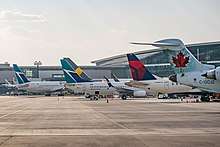
YYC's cargo operations grew significantly with 155,820 tonnes of cargo moving through the airport, an increase of 6.7% over the previous year.
Passenger and cargo traffic
Calgary International Airport passenger and cargo volumes for the period 2010–2019 are provided in the following table:
| Year | Passengers | Change | Cargo (kkg) | Change | Notes |
|---|---|---|---|---|---|
| 2010 | 12,630,695 | 120,000 | [89][36] | ||
| 2011 | 12,770,988 | 116,000 | [36] | ||
| 2012 | 13,641,339 | 119,000 | [90][91] | ||
| 2013 | 14,316,074 | 122,000 | [lower-alpha 1][90][91] | ||
| 2014 | 15,261,108 | 128,710 | [90][91] | ||
| 2015 | 15,475,759 | 134,695 | [lower-alpha 2][90][92] | ||
| 2016 | 15,680,616 | 137,255 | [92][93] | ||
| 2017 | 16,275,862 | 147,000 | [94][95] | ||
| 2018 | 17,343,402 | 146,000 | [96] | ||
| 2019 | 17,957,780 | 155,820 | [96] |
Top domestic routes
| Rank | Destinations | Flights Per Week |
|---|---|---|
| 1 | Vancouver (YVR) | 220 |
| 2 | Edmonton (YEG) | 175 |
| 3 | Toronto–Pearson (YYZ) | 168 |
| 4 | Saskatoon (YXE) | 91 |
| 5 | Kelowna (YLW) | 90 |
| 6 | Winnipeg (YWG) | 83 |
| 7 | Regina (YQR) | 79 |
| 8 | Fort McMurray (YMM) | 67 |
| 9 | Grande Prairie (YQU) | 64 |
| 10 | Victoria (YYJ) | 62 |
Ground transportation
Deerfoot Trail provides freeway access to the rest of the city.[98] There is also a tunnel beneath Runway 17L/35R that links the east side of the airport site to the terminal buildings.[99] Two parking garages and a rental-car facility are situated across from the terminals.[53][100] Public transport options are also available at the airport: Buses operated by Calgary Transit link YYC Calgary International to downtown, a nearby station of the local CTrain light-rail network, and other parts of the city.[101][102]
Notable accidents and incidents
- On 10 May 1945, Royal Air Force No. 105 Squadron de Havilland DH.98 Mosquito B Mk IX (LR503) struck the control tower roof shortly after takeoff, shearing off the planes port wing, and crashed into the ground killing both crew members. The Mosquito, known as "F for Freddie" was a survivor of 213 operations over Europe, and crashed while performing a low level pass for spectators prior to flying to Red Deer and Lethbridge as part of cross country tour to support to garner support for 8th Victory Loan Drive.[103]
- On 24 August 1963, West Coast Airlines Flight 794, a Fairchild F-27 departing from Spokane International Airport to Calgary via Cranbrook made a crash-landing shortly before the runway. The probable cause of the accident was the pilot failed to maintain the approved minimum altitude on approach. There were no fatalities.[104]
- On 22 March 1984, Pacific Western Airlines Flight 501, a Boeing 737-200, aborted a take-off and exited the runway onto a taxiway after a component of the left engine broke off and hit the fuel stores in the wing, resulting in a fire that spread over the left and back portions of the plane. The flight attendants evacuated all passengers, while some suffered severe injuries, all the occupants survived.[105][106]
- On 17 July 1990, an Ecuadorian Air Force de Havilland Canada DHC-5 Buffalo (Registration HC-BFH) being ferried to Calgary from Quito, via Billings had the nosegear collapsed following touchdown on runway 28, igniting hydraulic fuel and resulting in the aircraft burning out. There were no fatalities.[107]
See also
- List of the busiest airports in Canada
- List of the busiest airports in North America
Notes
- Calgary International became the third-busiest airport in Canada for the first time, ahead of Montréal–Trudeau International Airport
- Calgary International became the third-busiest airport in Canada for the second time, ahead of Montréal–Trudeau International Airport
References
- Canada Flight Supplement. Effective 0901Z 16 July 2020 to 0901Z 10 September 2020.
- "Synoptic/Metstat Station Information". Environment Canada. Archived from the original on 1 December 2011.
- "Fact Sheet". YYC Calgary International Airport. Archived from the original on 13 January 2018. Retrieved 12 January 2018.
- "Passenger Statistics". YYC Calgary International Airport. Archived from the original on 7 April 2018. Retrieved 6 April 2018.
- "Total aircraft movements by class of operation – NAV CANADA towers". Statistics Canada. 30 May 2018. Retrieved 26 April 2020.
- Keenan, Greg (2 May 2014). "WestJet CEO sets his sights on international skies". The Globe and Mail. Archived from the original on 28 July 2014. Retrieved 3 August 2017.
A distinct corporate culture that forms part of the foundation of WestJet is evident in the airy, six-storey head office at its campus at Calgary International Airport and is mission critical for Mr. Saretsky.
- "Air Canada - In the United States". www.aircanada.com. Retrieved 18 February 2020.
- "Calgary International Airport - History". Simon Fraser University. 2004. Retrieved 1 August 2017.
- Dippel, Scott (24 October 2016). "Shiny new terminal just the latest in a long line of Calgary airports". Canadian Broadcasting Corporation. Archived from the original on 28 April 2017. Retrieved 1 August 2017.
- "Rutledge Hangar". HeRMIS. Government of Alberta. Retrieved 2 July 2020.
- Calgary 100: 100 year history of Calgary. Calgary, AB: Provost Promotions & Publications LTD. 1974. p. 138. Retrieved 2 July 2020.
- "Airports Yield $632.68 Profit in 11 Months". Calgary Herald. 27 December 1939. p. 10. Retrieved 15 July 2020.
- "Airport History". yyc.com. YYC Calgary International. Archived from the original on 20 December 2018. Retrieved 20 December 2018.
- Hatch, F. J. (1983). The Aerodrome of Democracy: Canada and the British Commonwealth Air Training Plan, 1939-1945 (PDF). Ottawa: Directorate of History, Department of National Defence. ISBN 0660114437. Retrieved 2 July 2020.
- "Airport Runway to be Extended". Calgary Herald. 21 February 1949. p. 1. Retrieved 14 July 2020.
- "Airport Runway Now Completed". Calgary Herald. 29 October 1949. p. 32. Retrieved 14 July 2020.
- Snell, Dick (1 June 1956). "It Took Six Long Years, But Result Is A Dandy". Calgary Herald. p. 38. Retrieved 10 July 2020.
- "Marler Officially Opens New Airport Terminal". Calgary Herald. 2 June 1956. p. 23.
- Shiels, Bob (27 December 1958). "Aviation in Calgary is Big Business". The Herald Magazine. Calgary. p. 1. Retrieved 14 July 2020.
- "Airport To Keep 'McCall'". Calgary Herald. 9 April 1962. p. 1. Retrieved 10 July 2020.
- Hull, Ken (5 November 1968). "Calgary Airport To Achieve International Status In 1969". Calgary Herald. p. 1. Retrieved 10 July 2020.
- Calgary Airport Authority (12 July 2002). "Thank You Calgary". Calgary Herald. p. B6.
- "Tons of Equipment, Material Used to Complete New City Jet Runway". Calgary Herald. 15 September 1961. p. 23. Retrieved 14 July 2020.
- "Airport Face-Lift Costs $4 Million". Calgary Herald. 19 June 1963. p. 16. Retrieved 14 July 2020.
- Bye, Cristine (11 October 1977). "Ten years later, federal promise has been kept". Calgary Herald. p. G7. Retrieved 10 July 2020.
- Marshall, Andy (2016). Thin Power: How former Calgary Mayor Rod Sykes stamped his brand on the city . . . And scorched some sacred cows. FriesenPress. pp. 168–175. ASIN B01IQ54CUE. ISBN 1460283961.
- Simaluk, Vern (14 October 1977). "Concorde: one word for it - beautiful". Calgary Herald. pp. A1. Retrieved 10 July 2020.
- "First 747 arrives May 5". Calgary Herald. 12 January 1973. p. 38.
- Dardis, Wilf (27 June 1974). "Calgary-London route opens". Calgary Herald. p. 30.
- "Strikes turn Calgary into jumbo testing site". Calgary Herald. 19 April 1974. p. 33.
- Zdeb, Chris (31 July 2015). "Aug. 1, 1974: Province swoops in to take over Pacific Western Airlines". Edmonton Journal. Retrieved 2 July 2020.
- Canadian Airlines (2000). Investor & Financial Information Overview. Calgary. Archived from the original on 2 March 2000.
- "Indepth: Air Canada Timeline". CBC News. 20 June 2005. Archived from the original on 21 April 2006. Retrieved 4 April 2009.
- Institute for Governance of Private and Public Organizations (2014). The Governance of Canadian Airports: Issues and Recommendations (PDF) (Report). Institute for Governance of Private and Public Organizations. p. 8. Retrieved 2 July 2020.
- Stephenson, Amanda (7 December 2016). "Calgary airport CEO: Privatization no cure for high cost of air travel in Canada". Calgary Herald. Archived from the original on 22 December 2016. Retrieved 1 August 2017.
- SNC-Lavalin (April 2012). Calgary Airport Authority 5 Year Performance Review (2007-2011) (PDF). Calgary, AB: YYC Calgary Airport Authority. Retrieved 9 July 2020.
- Gilligan, Melissa (31 July 2014). "Tear-down of old air traffic control tower begins at Calgary airport". Global News. Calgary, AB. Retrieved 3 July 2020.
- AECOM. Volume II – Information Necessary to Complete the Environmental Assessment Chapter 7 – Project Description (PDF) (Report). The Calgary Airport Authority. pp. 7–59. Retrieved 3 July 2020.
- "WestJet's inspirational ascent from humble beginnings". CTV News. 18 February 2015. Archived from the original on 2 August 2017. Retrieved 1 August 2017.
- Fortney, Valerie (18 February 2016). "Fortney: One of WestJet's first pilots celebrates 20 years of flying with one last flight". Calgary Herald. Retrieved 15 July 2020.
- "Congressional Bills 112th US Congress - H. Res. 286 Introduced in House (IH)". US Government. Retrieved 12 July 2014.
- AECOM (2008). "Parallel Runway Project: Project Description and Scoping Document" (PDF). yyc.com. Calgary Airport Authority. Retrieved 2 July 2020.
- "NAV CANADA Opens Tallest Free-Standing Air Traffic Control Tower in Canada at Calgary International Airport". yyc.com. Ottawa, ON: NAV CANADA. 3 July 2013. Retrieved 3 July 2020.
- "New Calgary runway officially open". Canadian Broadcasting Corporation. 29 June 2014. Archived from the original on 26 December 2016. Retrieved 1 August 2017.
- Dippel, Scott (21 May 2014). "Calgary airport tunnel by the numbers". Canadian Broadcasting Corporation. Calgary. Retrieved 2 July 2020.
- "Airport tunnel a top priority, Nenshi vows". Canadian Broadcasting Corporation. Calgary. 20 October 2010. Retrieved 2 July 2020.
- "Calgary International Airport Development Programme, Calgary". airport-technology.com. Airport Technology. Retrieved 3 July 2020.
- Baskas, Harriet (31 October 2016). "New international terminal opens at Calgary Airport". USA Today. Archived from the original on 2 August 2017. Retrieved 1 August 2017.
- "YYC Officially Opens New International Terminal". The Calgary Airport Authority. Calgary, AB. 31 October 2016. Retrieved 3 July 2020.
- Tarasko, Mike (6 October 2016). "City airport officially named "YYC Calgary International"". 660 News. Archived from the original on 2 August 2017. Retrieved 1 August 2017.
- "Calgary Airport Domestic Terminal". calgary-airport.com. Retrieved 15 July 2020.
- "Calgary Airport International Terminal". calgary-airport.com. Retrieved 15 July 2020.
- "Terminal maps" (PDF). YYC Calgary International Airport. Archived (PDF) from the original on 3 August 2017. Retrieved 1 August 2017.
- "Preclearance locations". U.S. Customs and Border Protection. 22 June 2017. Archived from the original on 15 August 2017. Retrieved 2 August 2017.
- Jarvie, Michele (31 October 2016). "Opening day flies by at new Calgary airport terminal". Calgary Herald. Archived from the original on 6 April 2017. Retrieved 1 August 2017.
- Stephenson, Amanda (27 December 2016). "WestJet CEO blasts new terminal at YYC, says airport authority hasn't listened to concerns". Calgary Herald. Archived from the original on 8 July 2017. Retrieved 1 August 2017.
- Tighe, Tony (21 December 2016). "WestJet says passengers upset with Calgary airport connection travel times". Global News. Archived from the original on 2 August 2017. Retrieved 2 August 2017.
- "Aircraft Noise Management". yyc.com. YYC Calgary International Airport. Retrieved 14 July 2020.
- Bradley, Jennifer (August 2014). "Calgary Int'l builds Canada's longest runway". Airport Improvement. Retrieved 8 September 2017.
- Stephenson, Amanda (16 June 2014). "New $600-million runway takes off at Calgary airport". Calgary Herald. Archived from the original on 9 January 2018. Retrieved 8 September 2017.
- Parker, David (17 June 2016). "Parker: Calgary airport cargo traffic takes off". Calgary Herald. Archived from the original on 25 August 2016. Retrieved 3 August 2017.
- Vaessen, Doug; Freeman, Jenna (22 October 2014). "Massive cargo plane touches down at YYC for first time". Global News. Archived from the original on 4 August 2017. Retrieved 3 August 2017.
- "YYC ranked best Canadian Cargo Airport and receives prestigious 2011 Air Cargo World Award". Calgary Airport Authority. Calgary, AB: Airport Review. 28 July 2011. Retrieved 9 July 2020.
- "The Calgary Airport Marriott In-Terminal Hotel Has Now Checked-In to YYC" (Press Release). YYC Calgary International Airport. 1 September 2016. Retrieved 15 July 2020.
- "Onsite hotels". yyc.com. YYC Calgary International Airport. Archived from the original on 4 August 2017. Retrieved 3 August 2017.
- Elliott, Tamara; Boushy, David (3 July 2013). "Look up, way up! Calgary Airport unveils new air traffic control tower". Global News. Archived from the original on 4 August 2017. Retrieved 3 August 2017.
- Elliott, Tamara (19 March 2013). "WestJet's new headquarters stay true to Calgary roots". Global News. Archived from the original on 4 August 2017. Retrieved 3 August 2017.
- "Air Canada S21 Calgary – Tokyo aircraft changes as of 04JUN20". Retrieved 5 June 2020.
- "Flight Schedules". Air Canada. Archived from the original on 23 March 2018. Retrieved 24 January 2018.
- "Flight Schedules". Air Canada. Archived from the original on 12 January 2019. Retrieved 4 January 2019.
- "Flight Schedule". Air North. Archived from the original on 26 December 2017. Retrieved 24 January 2018.
- "Flight Schedules". Alaska Airlinest. Archived from the original on 11 September 2017. Retrieved 24 January 2018.
- "Flight schedules and notifications". American Airlines. Archived from the original on 2 February 2017. Retrieved 6 January 2018.
- "Timetables". British Airways. Archived from the original on 30 March 2017. Retrieved 3 December 2017.
- "Route Map". Central Mountain Air. Archived from the original on 26 December 2017. Retrieved 24 January 2018.
- "Timetable". Condor Flugdienst. Archived from the original on 6 June 2017. Retrieved 24 January 2018.
- "Flight Schedules". Delta Air Lines. Archived from the original on 21 June 2015. Retrieved 24 January 2018.
- "Timetable Updates". Edelweiss Air. Archived from the original on 14 January 2018. Retrieved 24 January 2018.
- "Schedule". Flair Airlines. Archived from the original on 26 March 2018. Retrieved 20 July 2019.
- "Frontier". Archived from the original on 12 September 2017. Retrieved 23 March 2018.
- "View the Timetable". KLM. Archived from the original on 12 September 2017. Retrieved 24 January 2018.
- "Northern Air Scheduled Flights". Northern Air. Archived from the original on 1 February 2018. Retrieved 24 January 2018.
- "Our Routes" (PDF). Sunwing Airlines. Archived (PDF) from the original on 18 November 2017. Retrieved 24 January 2018.
- "United Flight Schedules". United Airlines. Archived from the original on 28 January 2017. Retrieved 24 January 2018.
- Liu, Jim. "WestJet delays Calgary – Rome launch to May 2021". Routesonline. Retrieved 14 July 2020.
- "Flight Schedules - when we fly". WestJet. Archived from the original on 10 February 2017. Retrieved 8 October 2017.
- https://www.routesonline.com/news/38/airlineroute/291469/westjet-delays-calgary-dawson-creek-launch-to-sep-2020/
- "YYC > Media > Facts & Figures > Passenger Statistics". www.yyc.com. YYC Calgary International Airport. Retrieved 22 February 2020.
- "ACI - North American airports traffic (2010)". Airports Council International. Archived from the original on 16 March 2012.
- "Cargo Statistics". YYC Calgary International Airport. Calgary Airport Authority. Archived from the original on 8 May 2018. Retrieved 7 May 2018.
- "Calgary International Airport local E&D passenger statistics" (PDF). YYC Calgary International Airport. Calgary Airport Authority. 27 January 2015. Archived from the original (PDF) on 14 February 2015. Retrieved 3 August 2017.
- "Calgary International Airport local E&D passenger statistics" (PDF). YYC Calgary International Airport. Calgary Airport Authority. 19 July 2017. Archived from the original (PDF) on 3 August 2017. Retrieved 3 August 2017.
- "YYC's Passenger Numbers and Cargo Volumes Grow Again in 2016". yyc.com. YYC Calgary International Airport. 27 January 2017. Retrieved 3 July 2020.
- "Calgary International Airport local E&D passenger statistics" (PDF). YYC Calgary International Airport. Calgary Airport Authority. 20 August 2018. Archived from the original (PDF) on 22 August 2018. Retrieved 3 August 2017.
- "YYC Achieves Record Passenger Volumes in 2017". yyc.com. YYC Calgary International Airport. 1 February 2018. Retrieved 3 July 2020.
- "Calgary International Airport Local E&D Passenger Statistics" (PDF). www.yyc.com. Calgary Airport Authority. Retrieved 2 July 2020.
- "Top routes from YYC". Flightradar24. Archived from the original on 23 October 2019. Retrieved 23 October 2019.
- Google (4 August 2017). "Calgary International Airport (YYC)" (Map). Google Maps. Google. Retrieved 4 August 2017.
- Ho, Clara (26 May 2014). "Traffic takes off through $295-million tunnel". Calgary Herald. Archived from the original on 22 August 2016. Retrieved 4 August 2017.
- "Car rentals". YYC Calgary International Airport. Archived from the original on 27 July 2017. Retrieved 4 August 2017.
- "Route 100 - Airport/McKnight Stn". Calgary Transit. Archived from the original on 4 August 2017. Retrieved 4 August 2017.
- "Route 300 - BRT Airport/City Centre". Calgary Transit. Archived from the original on 4 August 2017. Retrieved 4 August 2017.
- de Boer, Richard (1996). "F For Freddie – Calgary's VE Day Tragedy". bombercommandmuseum.ca. Bomber Command Museum of Canada. Retrieved 2 July 2020.
- "Accident description for West Coast Airlines Flight 794". Aviation Safety Network. Flight Safety Foundation. 4 August 2017. Archived from the original on 5 August 2017. Retrieved 4 August 2017.
- "Accident description for Pacific Western Airlines Flight 501". Aviation Safety Network. Flight Safety Foundation. 4 August 2017. Archived from the original on 27 January 2012. Retrieved 4 August 2017.
- "Related accidents/incidents". Federal Aviation Administration. Archived from the original on 5 August 2017. Retrieved 4 August 2017.
- "Accident Description". Aviation Safety Network. Flight Safety Foundation. Retrieved 11 March 2020.
External links
| Wikimedia Commons has media related to Calgary International Airport. |
- Official website
- Past three hours METARs, SPECI and current TAFs for Calgary International Airport from Nav Canada as available.
- Rutledge Hangar. Canadian Register of Historic Places.